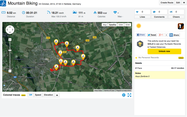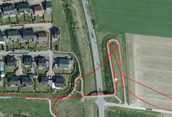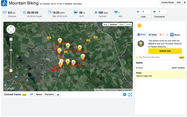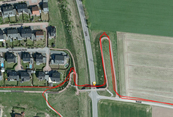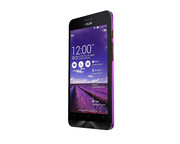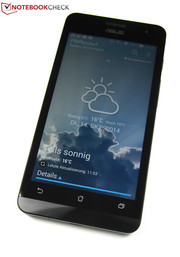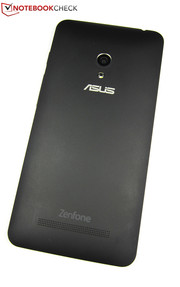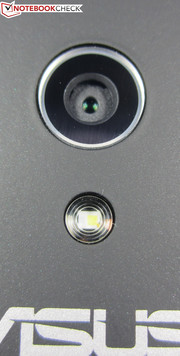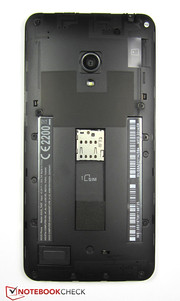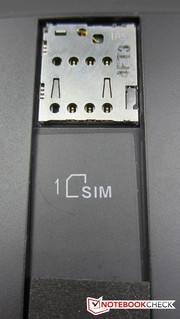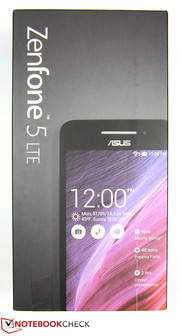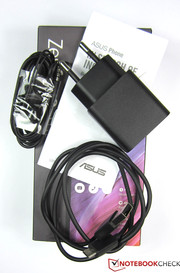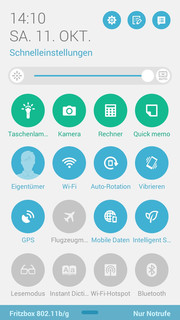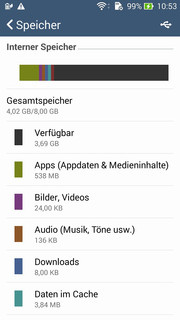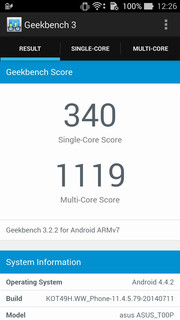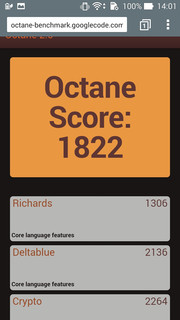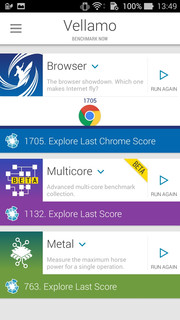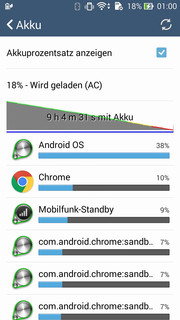Asus Zenfone 5 Smartphone Review

For the original German review, see here.
It won the Red Dot Design Award 2014 in the product design category, but it is still an entry-level device and comparatively inexpensive: Even this combination makes the Asus Zenfone 5 A500KL an interesting smartphone with a recommended retail price of 279 Euros (~$342). But that is not all; according to the manufacturer, the 5-inch Android device is supposed to convince customers with a long list of features, fast communication modules and a lot of extras.
If you ignore these marketing slogans and focus on the specifications, you can quickly see that the Zenfone 5 actually uses decent components. It is equipped with the quad-core SoC Qualcomm Snapdragon 400 MSM8926 and a wireless module that supports GSM, UMTS and also LTE with transfer rates of up to 150 Mbps. Furthermore, you get an 8 MP main camera, Android 4.4.2, 8 GB storage (gross) as well as an IPS display with 1280x720 pixels. Is it a good overall package? Let’s find out.
Case
Does the Zenfone 5 deserve a design award? Well, that is mainly a matter of personal taste. The Android device looks nice at first, but it does not really differ from other 5-inch smartphones. The only exception is the aluminum bar at the bottom, which is a real eye-catcher with its fine surface structure.
As soon as you pick up the Zenfone 5 you will be convinced by the haptic quality, which is an indicator why the Red Dot jury really liked the smartphone. Thanks to its slightly rounded back that is also rubberized and feels conveniently silky, the Asus is really comfortable to hold. However, the Zenfone is slightly thicker than similarly sized smartphones with 10.3 millimeters because of the convex back. With a height of just 7.7 millimeters, the 5.3-inch Sony Xperia T3 is the thinnest device within the comparison, while the HTC Desire 610 (4.7-inch) is very close to the Asus with 9.7 millimeters. Under the detachable back cover of the Zenfone 5 (145 grams) are the easily accessible slots for micro SIM and microSD cards. The lithium-ion battery cannot be removed.
The HD display of the Zenfone 5 is protected by a glass surface that is made of Corning Gorilla Glass 3, which has a seamless transition to the case. According to the manufacturer, the scratch-proof surface has a dirt-repellant coating that should ensure good visibility of the screen. However, we did not notice this feature during the review; the Asus display attracts fingerprints just like any other current smartphone display.
Connectivity
The heart of the Asus Zenfone 5 is the Qualcomm SoC Snapdragon 400 MSM8926 with four cores that are clocked at 1.2 GHz. This SoC is supported by the integrated GPU Qualcomm Adreno 305, 1 GB memory as well as 8 GB storage, even though the user can only use around 3.7 GB ex-works. The storage can be extended by up to 64 GB via microSD slot; under the back cover is also a slot for micro-SIM cards.
Software
The operating system of the Zenfone 5 is Android 4.4.2, but Asus uses its customized user interface ZenUI. The main focus of ZenUI is a simple handling, which also includes the quick settings that can be accessed with a swipe gesture from the top right. These quick settings include the most important functions of the smartphone, for example, the display brightness, GPS, WLAN, Bluetooth and the rotation lock.
Numerous apps are preloaded, including Asus tools like an organizer, a file manager and the cloud service Asus WebStorage with 5 GB storage for free. The software additions also include Google apps like Chrome, Maps and YouTube as well as apps for Kindle and Facebook.
Communication & GPS
The communication modules are one highlight of the Zenfone 5. Besides GSM quad-band and UMTS quad-band, the smartphone also supports LTE (bands 3, 7, 8 and 20). The maximum download rate for UMTS with HSDPA+ is up to 42 Mbps and up to 150 Mbps for LTE. We did not notice any problems during test calls with the Zenfone 5, the signal quality was always great, both for calls to landlines and mobile networks.
If you want to use the Zenfone 5 in local networks, you can choose between WLAN 802.11 b/g/n and Bluetooth 4.0. The Asus smartphone can locate your current position via GPS, A-GPS as well as GLONASS and includes WLAN and the mobile network to improve accuracy.
The Zenfone 5 locates the current position very accurately and is therefore well-suited for navigation apps and local searches. The review sample is actually a good rival for the professional navigation device Garmin Edge 500 on our 10-km bicycle ride, even though the Zenfone has some issues at very narrow parts of the track.
Cameras & Multimedia
The main camera of the Zenfone takes pictures with up to 8 MP in a 4:3 aspect ratio (3200x2400 pixels). 16:9 pictures are possible as well, but the resolution is limited to 6 MP (3200x1800 pixels) in this case. Videos can be recorded in Full HD, whereas the 2 MP webcam supports the HD resolution for videos. Users can choose between numerous settings for both cameras, including basic picture parameters like white balance, ISO number and exposure up to picture modes like self-timer, facial recognition or pre-defined scenes. Amongst others, the latter include presets like Cartoon, Sepia, Lomo and Grayscale.
The quality of pictures that were taken with the Zenfone 5 cannot quite compete with an iPhone 6 or Nokia Lumia 1020 since they lack the last bit of dynamic and sharpness. However, the Asus takes decent pictures that should be convenient for occasional shots.
Accessories & Warranty
Asus equips the Zenfone 5 with a modular power adaptor, a micro-USB cable, in-ear headphones as well as a quick-start guide. Covers in different colors (red, black, gold, white and transparent) are offered on the website of the manufacturer. At the time of writing, the prices are between 14 and 19 Euros (~$17 to ~$23). Asus grants a warranty of 24 months for its smartphone.
Input Devices & Handling
Thanks to its quad-core processor, the Asus Zenfone 5 quickly executes finger inputs, both via Android buttons or the touchscreen. There are no delays when you launch apps or switch between home screens, even after a cold start. One important factor for the fast handling is the quick and reliable rotation of the display and the virtual keyboard. The latter has an additional row of numbers in both orientations, so you don’t have to switch between layouts and inputs are faster in general.
Display
The IPS display of the Zenfone 5 has 1280x720 pixels, which is not a matter of course for a 5-inch smartphone. Many rivals have significantly lower resolutions, including almost every device within our comparison. The Nokia Lumia 630, for instance, only has 854x480 pixels, while the HTC Desire 610 and the Huawei Ascend G6 at least have 960x540 pixels. Only the Sony Xperia T3 supports the "small" HD resolution and is on a level with the Zenfone 5.
If you ignore the resolution and look at the other display specifications, you can see that all the comparison devices are very similar to the Zenfone 5. Our review sample reaches a good average brightness of 375 cd/m², which means it is no problem to use it outdoors. The Zenfone 5 also manages good results for the brightness distribution (88%), the black value of 0.58 cd/m² and the contrast ratio of 671:1. Subjectively, the display of the Asus produces rich colors and deep blacks.
| |||||||||||||||||||||||||
Brightness Distribution: 88 %
Center on Battery: 389 cd/m²
Contrast: 671:1 (Black: 0.58 cd/m²)
ΔE ColorChecker Calman: 4.22 | ∀{0.5-29.43 Ø4.78}
ΔE Greyscale Calman: 3.08 | ∀{0.09-98 Ø5}
Gamma: 2.57
CCT: 6840 K
| Asus Zenfone 5 Adreno 305, 400 MSM8926, 8 GB eMMC Flash | HTC Desire 610 Adreno 305, 400 MSM8226, 8 GB SSD | Huawei Ascend G6 Adreno 305, 400 MSM8226, 4 GB Flash | Nokia Lumia 630 Adreno 305, 400 MSM8226, 8 GB eMMC Flash | Sony Xperia T3 Adreno 305, 400 MSM8928, 8 GB SSD | |
|---|---|---|---|---|---|
| Screen | -23% | -21% | -31% | -17% | |
| Brightness middle (cd/m²) | 389 | 339 -13% | 418 7% | 355 -9% | 521 34% |
| Brightness (cd/m²) | 375 | 321 -14% | 417 11% | 350 -7% | 504 34% |
| Brightness Distribution (%) | 88 | 91 3% | 88 0% | 91 3% | 89 1% |
| Black Level * (cd/m²) | 0.58 | 0.55 5% | 0.61 -5% | 0.73 -26% | 0.77 -33% |
| Contrast (:1) | 671 | 616 -8% | 685 2% | 486 -28% | 677 1% |
| Colorchecker dE 2000 * | 4.22 | 5.98 -42% | 6.34 -50% | 7.19 -70% | 5.73 -36% |
| Greyscale dE 2000 * | 3.08 | 5.95 -93% | 6.53 -112% | 5.63 -83% | 6.83 -122% |
| Gamma | 2.57 86% | 2.51 88% | 2.11 104% | 1.97 112% | 3.46 64% |
| CCT | 6840 95% | 7398 88% | 7756 84% | 6293 103% | 8370 78% |
* ... smaller is better
Our measurements with the X-Rite i1Pro 2 spectrophotometer and the CalMAN software show that the Asus display is not perfectly calibrated, but the deviations are pretty low in general and you cannot notice them during everyday use. Example: The color temperature of the Zenfone 5 is a bit too "cool" with 6,840 K, but it is still pretty close to the ideal value of 6,500 K. The deviations for the grayscale (DeltaE of 3.08) and the ColorChecker (DeltaE of 4.22) are not far away from the ideal values, either.
It is no problem to use the Asus Zenfone 5 indoors or outdoors, the brightness of the IPS display (up to 398 cd/m²) should be sufficient for almost every scenario. The glossy display surface can obviously be annoying under certain lighting conditions, but it does not really affect the handling. The situation is slightly worse in regard to the viewing-angle stability of the Asus display. Extreme angles result in a dark picture and color shifts towards blue.
Performance
The Asus Zenfone 5 uses the quad-core SoC Qualcomm Snapdragon 400 MSM8926 with four Cortex A7 cores that are clocked with up to 1.2 GHz. The Adreno 305 GPU is integrated into the SoC as well. The MSM8926 is only used for entry-level devices, but the performance during our review is pretty high nonetheless and is easily sufficient for multimedia applications as well as current Android apps. This is also supported by the synthetic benchmarks.
| 3DMark - 1280x720 offscreen Ice Storm Unlimited Score (sort by value) | |
| Asus Zenfone 5 | |
| HTC Desire 610 | |
| Huawei Ascend G6 | |
| Sony Xperia T3 | |
| Geekbench 3 - 32 Bit Multi-Core Score (sort by value) | |
| Asus Zenfone 5 | |
| HTC Desire 610 | |
| Huawei Ascend G6 | |
| Sony Xperia T3 | |
| Linpack Android / IOS - Multi Thread (sort by value) | |
| Asus Zenfone 5 | |
| Huawei Ascend G6 | |
| Sony Xperia T3 | |
| GFXBench 3.0 - on screen Manhattan Onscreen OGL (sort by value) | |
| Asus Zenfone 5 | |
| HTC Desire 610 | |
| Huawei Ascend G6 | |
| Sony Xperia T3 | |
The browser-based benchmarks show a small advantage of the Zenfone 5 over the similarly equipped rivals. The Asus device is clearly ahead in SunSpider 1.02 and WebXPRT 2013 and is only beaten by the Sony Xperia T3 in Google Octane 2.0.
| Octane V2 - Total Score (sort by value) | |
| Asus Zenfone 5 | |
| HTC Desire 610 | |
| Huawei Ascend G6 | |
| Nokia Lumia 630 | |
| Sony Xperia T3 | |
| Sunspider - 1.0 Total Score (sort by value) | |
| Asus Zenfone 5 | |
| HTC Desire 610 | |
| Huawei Ascend G6 | |
| Nokia Lumia 630 | |
| Sony Xperia T3 | |
| WebXPRT 2013 - Overall (sort by value) | |
| Asus Zenfone 5 | |
| HTC Desire 610 | |
| Huawei Ascend G6 | |
| Nokia Lumia 630 | |
* ... smaller is better
The situation is closer when we look at the read and write operations, where the Zenfone 5 is neck and neck with the Sony Xperia T3. The HTC Desire 610 and the Huawei Ascend G6 are slightly slower than the two devices, whereby the Huawei manages the lowest transfer rates.
| AndroBench 3-5 | |
| Sequential Read 256KB (sort by value) | |
| Asus Zenfone 5 | |
| HTC Desire 610 | |
| Huawei Ascend G6 | |
| Sony Xperia T3 | |
| Sequential Write 256KB (sort by value) | |
| Asus Zenfone 5 | |
| HTC Desire 610 | |
| Huawei Ascend G6 | |
| Sony Xperia T3 | |
| Random Read 4KB (sort by value) | |
| Asus Zenfone 5 | |
| HTC Desire 610 | |
| Huawei Ascend G6 | |
| Sony Xperia T3 | |
| Random Write 4KB (sort by value) | |
| Asus Zenfone 5 | |
| HTC Desire 610 | |
| Huawei Ascend G6 | |
| Sony Xperia T3 | |
Gaming Performance
Powered by the quad-core SoC Qualcomm Snapdragon 400 MSM8926, the Asus has no problems to ensure smooth gameplay in current Android titles like FIFA 15, Ridge Racer Slipstream, Real Racing 3 and Shadowgun: Deadzone. Even top titles like Asphalt 8 are not a big challenge for the Adreno 305 GPU. However, because of its low performance reserves, the SoC should come to its limits sooner or later. Still, the Zenfone 5 is well-suited for current games.
Emissions
Temperature
With up to 36.4 °C, the Asus Zenfone 5 only gets lukewarm, even after one hour of maximum load. The only device that can keep up with this performance among the rivals is the HTC Desire 610, which is even slightly cooler with up to 36.2 °C. The other smartphones, however, get much warmer under load: The Huawei Ascend G6 reaches 42.2 °C, the Nokia Lumia 630 41.1 °C and the Sony Xperia T3 even up to 46 °C.
(+) The maximum temperature on the upper side is 34.9 °C / 95 F, compared to the average of 35.2 °C / 95 F, ranging from 21.9 to 247 °C for the class Smartphone.
(+) The bottom heats up to a maximum of 36.4 °C / 98 F, compared to the average of 34 °C / 93 F
(±) In idle usage, the average temperature for the upper side is 32.6 °C / 91 F, compared to the device average of 32.9 °C / 91 F.
Speakers
The Zenfone 5 has a speaker bar at the back. As expected, the sound is a bit tinny, but the quality is still okay. Bass is not available and medium tones are limited as well, which is typical for smartphones. The sound quality of the Asus is much better with the provided in-ear headphones.
Energy Management
Power Consumption
The power consumption is just as restrained as the temperature development. We can only measure 1.4 Watts while idling and a moderate 3.1 Watts under load. This means the bar is once again very high for the competitors and only one of these devices, the Huawei Ascend G6, has a lower consumption under maximum load (2.7 Watts). The other extreme is the Sony Xperia T3 with 4.9 Watts, but all the values are still perfectly okay.
| Off / Standby | |
| Idle | |
| Load |
|
Key:
min: | |
Battery Runtime
Our realistic WLAN test determines a runtime of 9:05 hours for the Asus Zenfone 5, so it should easily last a whole business day without a socket. Similarly enduring are the HTC Desire 610 (8:40 hours) and the Huawei Ascend G6 (9:20 hours), even though they cannot keep up with the best result: The Sony Xperia T3 lasts for 10:34 hours in the WLAN test, and the Nokia Lumia 620 even 14:34 hours.
| Asus Zenfone 5 Adreno 305, 400 MSM8926, 8 GB eMMC Flash | HTC Desire 610 Adreno 305, 400 MSM8226, 8 GB SSD | Huawei Ascend G6 Adreno 305, 400 MSM8226, 4 GB Flash | Nokia Lumia 630 Adreno 305, 400 MSM8226, 8 GB eMMC Flash | Sony Xperia T3 Adreno 305, 400 MSM8928, 8 GB SSD | |
|---|---|---|---|---|---|
| Battery runtime | -5% | -5% | 21% | -16% | |
| WiFi (h) | 9.1 | 8.7 -4% | 9.3 2% | 14.6 60% | 10.6 16% |
| Load (h) | 3.8 | 3.6 -5% | 3.4 -11% | 3.1 -18% | 2 -47% |
| H.264 (h) | 12.3 |
Verdict
The Zenfone 5 is a new powerful 5-inch entry-level device in Asus’ smartphone portfolio, which offers quite a lot of features for the comparatively low price. Highlights of the smartphone are the current Android 4.4.2 including ZenUI extension, LTE module, HD display with 1280x720 pixels and a scratch-proof Corning Gorilla Glass 3 surface as well as an 8 MP camera. Other positive aspects during the review were the long battery runtimes, the low operating temperatures and the fast responses.
However, you shouldn’t get the Zenfone 5 if you like to play games on your smartphone. The application and gaming performance is perfectly sufficient right now, but the Adreno 305 GPU does not have a lot of performance headroom for future titles. The internal storage of 8 GB is also limited; you can only use around 3.7 GB for your own files.











